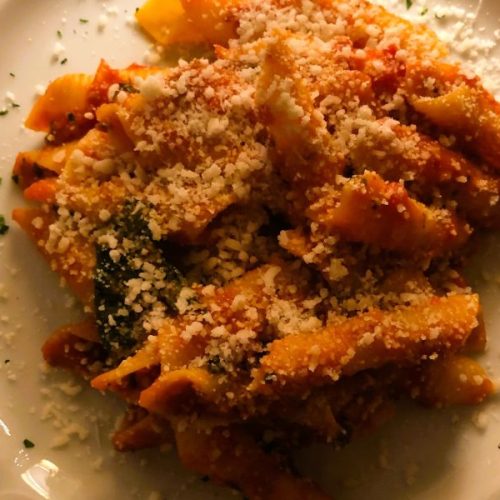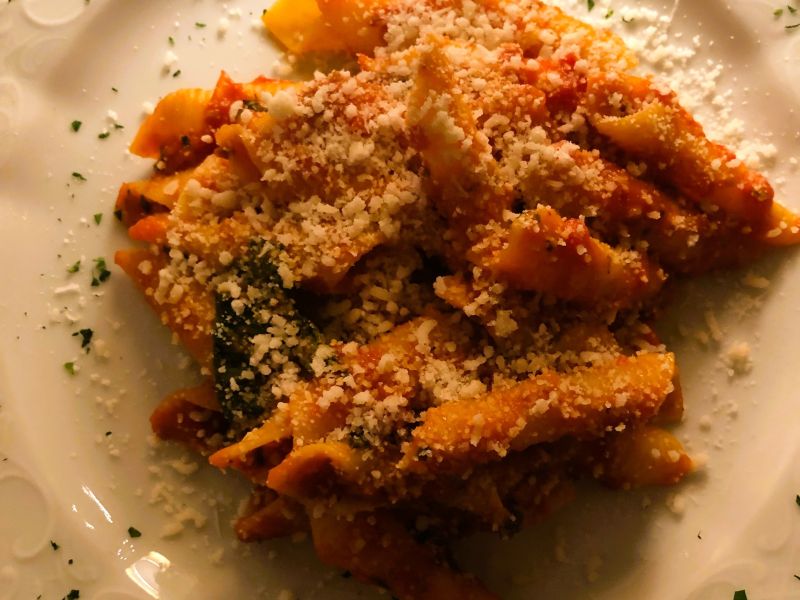Pasta Arrabbiata is one of Italy’s simplest yet most flavorful pasta dishes. The name “Arrabbiata” literally means “angry” in Italian, a playful nod to the spicy kick from the red pepper flakes. Originating in Rome, this dish is a staple of traditional Roman cuisine, alongside classics like Cacio e Pepe, Amatriciana, and Carbonara. Unlike its more famous counterparts, Arrabbiata embraces spice, making it a favorite among those who love bold flavors.
History Behind the Heat
The origins of Pasta Arrabbiata trace back to the mid-20th century, when post-war Italy was experiencing a culinary shift. While tomatoes had already been a key ingredient in Italian cuisine, adding red chili flakes was a more recent innovation. Farmers and home cooks in Rome experimented with spicing up simple pasta dishes, leading to the birth of Arrabbiata.
Traditionally, penne rigate is the pasta of choice because its ridged surface helps the sauce cling perfectly. The dish is also meant to be quick and inexpensive, making it a go-to for Italian families looking for a flavorful meal without much effort. Today, it’s served in trattorias across Italy and has gained international fame.
A Roman Classic Loved Around The World
You can find Pasta Arrabbiata in many of Rome’s best trattorias, such as Roscioli and Felice a Testaccio, where chefs stay true to the original recipe. The dish has been championed by well-known chefs like Gennaro Contaldo and Jamie Oliver, both of whom emphasize the importance of using high-quality tomatoes and extra virgin olive oil for the best flavor.
The dish even made its way onto Stanley Tucci’s show Searching for Italy, where he explored the fiery side of Roman cuisine. And while Arrabbiata might not have had a starring role in Hollywood, pasta itself has always been a cinematic icon. From Julia Roberts savoring a plate of spaghetti in Eat Pray Love to classic Italian films like La Dolce Vita, pasta represents the heart and soul of Italian culture.
Why Pasta Arrabbiata is More Than Just Spicy Pasta
While many see Arrabbiata as just another spicy tomato pasta, it’s actually a cultural symbol. It represents the simplicity and boldness of Roman cooking, where a few quality ingredients create unforgettable flavors. The dish is also deeply connected to Italy’s love for spicy food, something not commonly associated with Italian cuisine. However, regions like Calabria and Lazio (where Rome is located) have a deep-rooted tradition of using chili peppers, particularly in dishes like Nduja (spicy spreadable salami) and Peperoncino-based sauces.
Modern Takes and Variations
Although purists insist on keeping Arrabbiata simple, modern variations have emerged. Some add guanciale (cured pork cheek) for extra richness, while others toss in black olives or capers for a Mediterranean twist. In some restaurants, chefs use fresh cherry tomatoes instead of canned San Marzano tomatoes for a lighter, fresher taste. However, the core of Arrabbiata remains unchanged: garlic, olive oil, red pepper flakes, and tomatoes.
The Perfect Pairing: Wine & Side Dishes
If you’re enjoying a plate of Pasta Arrabbiata, pairing it with the right wine can enhance the experience. A bold, acidic wine like Montepulciano d’Abruzzo or Chianti Classico works well to balance the heat. For those who prefer white wine, a crisp Verdicchio can provide a refreshing contrast.
For side dishes, a simple Caprese salad or bruschetta with fresh tomatoes can complement the meal without overpowering the flavors. And if you’re feeling indulgent, finishing with a classic Tiramisu or Panna Cotta keeps things authentically Italian.
Final Thoughts: Why You Should Try Arrabbiata Tonight
Pasta Arrabbiata is a reminder that the best Italian food is often the simplest. With just a handful of pantry ingredients, you can create a dish that is bold, flavorful, and deeply satisfying. Whether you’re recreating a Roman trattoria experience at home or looking for an easy weeknight dinner, Arrabbiata is a must-try.
So, next time you’re in the mood for pasta with a fiery kick, remember the Roman classic that has been spicing up kitchens for decades.

Classic Pasta Arrabbiata
Equipment
- Large pot
- Large skillet or saucepan
- Wooden spoon
- Collander
Ingredients
- 12 oz Penne pasta Rigatoni or any Pasta Rigata
- 2 tbsp Olive oil
- 4 cloves Garlic minced
- 1 tsp Red pepper flakes or as needed
- 28 oz D.O.P San Marzano tomatoes crushed
- 1/4 cup Fresh parsley chopped
- 1/4 cup Pecorino Romano cheese grated
- Salt & Pepper to taste
Instructions
- Cook the Pasta – Bring a large pot of salted water to a boil. Add penne pasta and cook until al dente (about 8-10 minutes). Reserve 1/2 cup of pasta water, then drain.
- Sauté Garlic & Pepper Flakes – In a large skillet, heat olive oil over medium heat. Add minced garlic and red pepper flakes. Cook for 30 seconds to 1 minute, stirring, until fragrant but not browned. The spice should infuse the oil.
- Add Tomatoes – Pour in crushed San Marzano tomatoes, season with salt and black pepper, and stir. Let simmer for 15 minutes, stirring occasionally. For a smoother sauce, blend the tomatoes before adding by hand. Taste sauce and balance the taste with more olive oil or even baking soda – no sugar. Adding in a peeled carrot helps draw away the acidity. I also like adding bay leaves as well.
- Toss Pasta with Sauce – Add the cooked pasta to the sauce, along with a splash of pasta water to help coat the noodles. Stir well to combine and let simmer for 2 minutes.
- Finish & Serve – Remove from heat, toss in fresh parsley, and serve immediately with Pecorino Romano cheese.
Notes
- Adjust the spiciness by increasing or decreasing the red pepper flakes.
- For an even richer sauce, add a small pat of butter at the end.
- Traditionally, no onions or basil are used in Arrabbiata sauce.
